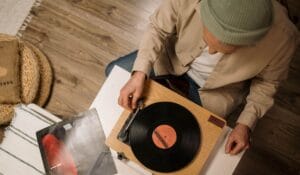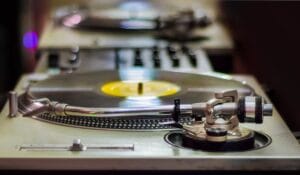01/05/2025
om 11:35 AM
Even Dave Grohl—rock’s enduring renaissance man, the man behind Foo Fighters and Nirvana’s big brother —was reminded of vinyl’s magic thanks to the magic of cinema — Cameron Crowe dropping the emotional bombshell of Almost Famous. Who didn’t feel it? That iconic moment when Elton John’s “Tiny Dancer”swept through the tour bus, stitching together broken hearts, frayed friendships, hopes dashed asunder, and innocence lost — it made everyone want to sing along. Suddenly, every viewer felt like Penny Lane, basking in the glorious ache of connection that only music can deliver.
“Music, you know, true music—it chooses you,” Crowe wrote. “It lives in your car, or alone, listening to your headphones, with vast scenic bridges and angelic choirs in your brain.” Vinyl is its most iconic representation, the proverbial page or medium on which most of those testaments are tied to. It’s physical, tangible, and drenched in nostalgia—like holding a memory in your hands. Sure, you can send a Spotify mixtape, but that’s the equivalent of sending out poetry not on a weathered piece of good parchment, written by hand, but on a WhatsApp followed by a couple of emojis. And now, thanks to modern technology, creating your own vinyl record isn’t just for record labels or collectors—it’s for anyone who wants to capture their music in its most soulful, enduring form.
As Bob Dylan once crooned, “Take care of your memories, for you cannot relive them.” A vinyl record is more than a format—it’s a memory, a story, and a slice of timeless art.
So, if you’re ready to etch your sound into wax and learn how to create custom vinyl records, here’s everything you need to know to get started.
Long thought to be a casualty of the digital age – the sequel to that all time hit of the video killing the radio start – vinyl has made a roaring comeback over the past decade. It has endured — the proverbial slasher that regardless of how many things you throw in its wake it keeps coming back, stronger, and with a bigger machete.
In 2022 alone, vinyl sales surged past CDs for the first time since 1987, proving that records are more than just a retro fad—they’re a cultural staple.
Why is vinyl so cherished? For starters, there’s the sound quality. Unlike digital files, which compress audio, vinyl delivers a warm, analog richness that feels alive. It’s there and it’s fragile — and part of that fragility is what gives it some much power.
Also, it’s not just sound — it’s texture, it’s sight, it’s the smell of it. In a way, vinyl sets off all our senses, and makes them work on overload — it taps into a primitive portion of our lizard brain and makes it come alive.
Listening to vinyl is iconic like hearing Fleetwood Mac’s “Dreams” for the first time. You know you’re listening to something powerful and enduring, something that will outlive the newest fad on the radio or this summer’s hit song. It spill out in slow motion and crawls into your soul —smooth, layered, and full of life. And you might not appreciate it right away, but you know that sooner or later your mind will come back to it.
Then there’s the ritual—sliding the record out of its sleeve, dropping the needle, and hearing that first crackle. It’s a multisensory experience, one that makes listening to music feel intentional and immersive.
And let’s not forget the collectability. Vinyl is art you can hold, whether it’s the haunting beauty of a minimalist album cover or the kaleidoscopic swirls of a colored pressing. It’s music, yes—but it’s also memory, craft, and connection, all wrapped in a 12-inch square.
“The poets down here don’t write nothing at all, they just stand back and let it all be.” That’s vinyl—it’s the poet standing back, letting you feel every note.

Before vinyl records became the heartbeat of a million living rooms, polyvinyl chloride (PVC) was already shaping the modern world. Invented in 1872, vinyl was initially a stiff, brittle material with little use. But by the 1920s, scientists discovered how to soften PVC, transforming it into a flexible, durable material.
Then came its musical debut. In the 1930s, vinyl replaced fragile shellac discs as the material of choice for records. By the 1950s, the rise of the LP (long-playing record) turned vinyl into a cultural juggernaut. Suddenly, music wasn’t just something you heard—it was something you experienced.
Vinyl wasn’t just a format or a medium it quickly became a traditional with its own rituals — ritual thaw would allow you to genuflect at the altar of great music:
And in the 60s and 70s, vinyl reached constant highs of greatness — each new album perfect and timeless. From Springsteen’s Born to Run, to Simon & Garfunkel’s fifth and final outing – Bridge Over Troubled Water. Each wasn’t just a recording —but a biography of the time, the ethos, the turmoil of its band members. Think we’re being hyperbolic? Just listen to Rumourss from Fleetwood Mac – and the song The Chain – to get an inkling of the madness that was running wild through its artist. Every groove is alive with passion, intrigue, drama, and hope.
Creating your own vinyl record lets you tap into that legacy. It’s more than music—it’s history in your hands.
Every great record begins with an idea. Is this a passion project? A collectible for fans? A family keepsake? Your vision will shape everything from the tracklist to the artwork.
Mastering vinyl is different from digital. Vinyl has physical limitations—too much bass or volume can cause distortion or skipping. A professional mastering engineer ensures your tracks are optimized for wax.
Selecting the right pressing plant is crucial. Look for companies with a reputation for precision, timely delivery, and good customer support. Popular options include:

Make your vinyl unforgettable by going beyond sound:
Exclusivity is the name of the game. Add value with:
When your records arrive, take a moment. Inspect them, admire them, and listen. Whether you’re pressing for fun, business, or art, this is a project you’ll never forget.
Let’s round it out and go back to Cameron Crowe – the Rolling Stone writer and movie director -“music is a place apart.” And vinyl is the map that gets you there. Music, some say is the ultimate art form, is what all other art strives to be. It’s fast and makes a connection unlike any other. And, at it’s core, creating a custom vinyl record isn’t just about sound—it’s about telling a story, capturing a moment, and holding it in your hands.
Whether it’s your first attempt or your magnum opus, don’t just create music—create a legacy. “Take those broken wings and learn to fly” — Your vinyl is waiting—make it unforgettable.
|
Uploaded
Failed
|
 |
We use functional and analytical cookies for an optimal website experience and statistics. More information